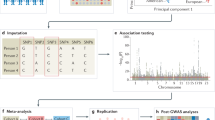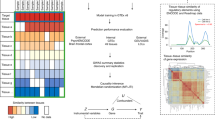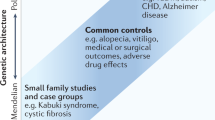Abstract
Epigenome-wide association studies (EWAS) hold promise for the detection of new regulatory mechanisms that may be susceptible to modification by environmental and lifestyle factors affecting susceptibility to disease. Epigenome-wide screening methods cover an increasing number of CpG sites, but the complexity of the data poses a challenge to separating robust signals from noise. Appropriate study design, a detailed a priori analysis plan and validation of results are essential to minimize the danger of false positive results and contribute to a unified approach. Epigenome-wide mapping studies in homogenous cell populations will inform our understanding of normal variation in the methylome that is not associated with disease or aging. Here we review concepts for conducting a stringent and powerful EWAS, including the choice of analyzed tissue, sources of variability and systematic biases, outline analytical solutions to EWAS-specific problems and highlight caveats in interpretation of data generated from samples with cellular heterogeneity.
This is a preview of subscription content, access via your institution
Access options
Subscribe to this journal
Receive 12 print issues and online access
$259.00 per year
only $21.58 per issue
Buy this article
- Purchase on SpringerLink
- Instant access to full article PDF
Prices may be subject to local taxes which are calculated during checkout


Similar content being viewed by others
References
McCarthy, M.I. et al. Genome-wide association studies for complex traits: consensus, uncertainty and challenges. Nat. Rev. Genet. 9, 356–369 (2008).
Bernstein, B.E. et al. The NIH Roadmap Epigenomics Mapping Consortium. Nat. Biotechnol. 28, 1045–1048 (2010).
Satterlee, J.S., Schubeler, D. & Ng, H.H. Tackling the epigenome: challenges and opportunities for collaboration. Nat. Biotechnol. 28, 1039–1044 (2010).
Adams, D. et al. BLUEPRINT to decode the epigenetic signature written in blood. Nat. Biotechnol. 30, 224–226 (2012).
Bock, C. et al. Quantitative comparison of genome-wide DNA methylation mapping technologies. Nat. Biotechnol. 28, 1106–1114 (2010).
Harris, R.A. et al. Comparison of sequencing-based methods to profile DNA methylation and identification of monoallelic epigenetic modifications. Nat. Biotechnol. 28, 1097–1105 (2010).
Bock, C. Analysing and interpreting DNA methylation data. Nat. Rev. Genet. 13, 705–719 (2012).This paper provides a comprehensive review of the computational methods and available software tools for the analysis of DNA methylation data.
Hansen, K.D., Wu, Z., Irizarry, R.A. & Leek, J.T. Sequencing technology does not eliminate biological variability. Nat. Biotechnol. 29, 572–573 (2011).
Jaffe, A.E., Feinberg, A.P., Irizarry, R.A. & Leek, J.T. Significance analysis and statistical dissection of variably methylated regions. Biostatistics 13, 166–178 (2012).
Bibikova, M. et al. High-throughput DNA methylation profiling using universal bead arrays. Genome Res. 16, 383–393 (2006).
Michels, K.B. Epigenetic Epidemiology (Springer, 2012). This is the first textbook on epigenetic epidemiology providing guidance to epidemiologists and epigeneticists alike how to design, conduct and analyze an epigenetic epidemiology study.
Mill, J. & Heijmans, B.T. From promises to practical strategies in epigenetic epidemiology. Nat. Rev. Genet. 14, 585–594 (2013).
Rakyan, V.K., Down, T.A., Balding, D.J. & Beck, S. Epigenome-wide association studies for common human diseases. Nat. Rev. Genet. 12, 529–541 (2011).
Silviera, M.L., Smith, B.P., Powell, J. & Sapienza, C. Epigenetic differences in normal colon mucosa of cancer patients suggest altered dietary metabolic pathways. Cancer Prev. Res. (Phila.) 5, 374–384 (2012).
Houseman, E.A. et al. DNA methylation arrays as surrogate measures of cell mixture distribution. BMC Bioinformatics 13, 86 (2012).This paper describes a new method to statistically adjust for the cell mixture distribution of blood cells using DNA methylation marks.
Reinius, L.E. et al. Differential DNA methylation in purified human blood cells: implications for cell lineage and studies on disease susceptibility. PLoS ONE 7, e41361 (2012).
Koestler, D.C. et al. Peripheral blood immune cell methylation profiles are associated with nonhematopoietic cancers. Cancer Epidemiol. Biomarkers Prev. 21, 1293–1302 (2012).
Abbas, A.R., Wolslegel, K., Seshasayee, D., Modrusan, Z. & Clark, H.F. Deconvolution of blood microarray data identifies cellular activation patterns in systemic lupus erythematosus. PLoS ONE 4, e6098 (2009).
Liu, Y. et al. Epigenome-wide association data implicate DNA methylation as an intermediary of genetic risk in rheumatoid arthritis. Nat. Biotechnol. 31, 142–147 (2013).
Saferali, A. et al. Cell culture-induced aberrant methylation of the imprinted IG DMR in human lymphoblastoid cell lines. Epigenetics 5, 50–60 (2010).
Sugawara, H. et al. Comprehensive DNA methylation analysis of human peripheral blood leukocytes and lymphoblastoid cell lines. Epigenetics 6, 508–515 (2011).
Caliskan, M., Cusanovich, D.A., Ober, C. & Gilad, Y. The effects of EBV transformation on gene expression levels and methylation profiles. Hum. Mol. Genet. 20, 1643–1652 (2011).
Michels, K.B. The promises and challenges of epigenetic epidemiology. Exp. Gerontol. 45, 297–301 (2010).
Teschendorff, A.E., Zhuang, J. & Widschwendter, M. Independent surrogate variable analysis to deconvolve confounding factors in large-scale microarray profiling studies. Bioinformatics 27, 1496–1505 (2011).
Leek, J.T. et al. Tackling the widespread and critical impact of batch effects in high-throughput data. Nat. Rev. Genet. 11, 733–739 (2010).
Dedeurwaerder, S. et al. Evaluation of the Infinium Methylation 450K technology. Epigenomics 3, 771–784 (2011).This paper provides an in-depth discussion of the 450K Infinium microarray technology for DNA methylation.
Smith, Z.D. et al. A unique regulatory phase of DNA methylation in the early mammalian embryo. Nature 484, 339–344 (2012).
Boyle, P. et al. Gel-free multiplexed reduced representation bisulfite sequencing for large-scale DNA methylation profiling. Genome Biol. 13, R92 (2012).This paper describes the methods for the multiplex adaptation of RRBS for DNA methylation.
Bock, C. et al. DNA methylation dynamics during in vivo differentiation of blood and skin stem cells. Mol. Cell 47, 633–647 (2012).
Liu, Y., Siegmund, K.D., Laird, P.W. & Berman, B.P. Bis-SNP: combined DNA methylation and SNP calling for Bisulfite-seq data. Genome Biol. 13, R61 (2012).
Du, P., Kibbe, W.A. & Lin, S.M. lumi: a pipeline for processing Illumina microarray. Bioinformatics 24, 1547–1548 (2008).
Goecks, J., Nekrutenko, A. & Taylor, J. Galaxy: a comprehensive approach for supporting accessible, reproducible, and transparent computational research in the life sciences. Genome Biol. 11, R86 (2010).
Halachev, K., Bast, H., Albrecht, F., Lengauer, T. & Bock, C. EpiExplorer: live exploration and global analysis of large epigenomic datasets. Genome Biol. 13, R96 (2012).
Smyth, G.K. Linear models and empirical bayes methods for assessing differential expression in microarray experiments. Stat. Appl. Genet. Mol. Biol. 3, 3 (2004).
Akey, J.M., Biswas, S., Leek, J.T. & Storey, J.D. On the design and analysis of gene expression studies in human populations. Nat. Genet. 39, 807–808; author reply 808–809 (2007).
Johnson, W.E., Li, C. & Rabinovic, A. Adjusting batch effects in microarray expression data using empirical Bayes methods. Biostatistics 8, 118–127 (2007).
Jaffe, A.E. et al. Bump hunting to identify differentially methylated regions in epigenetic epidemiology studies. Int. J. Epidemiol. 41, 200–209 (2012).In this paper the authors suggest a new computational method for detecting differently methylated regions based on a techniques that borrows statistical power from adjacent locations to produce estimates that are substantially more precise than single-locus methods.
Hansen, K.D., Langmead, B. & Irizarry, R.A. BSmooth: from whole genome bisulfite sequencing reads to differentially methylated regions. Genome Biol. 13, R83 (2012).
Langevin, S.M. et al. The influence of aging, environmental exposures and local sequence features on the variation of DNA methylation in blood. Epigenetics 6, 908–919 (2011).
Feinberg, A.P. & Irizarry, R.A. Evolution in health and medicine Sackler colloquium: stochastic epigenetic variation as a driving force of development, evolutionary adaptation, and disease. Proc. Natl. Acad. Sci. USA 107 (suppl. 1), 1757–1764 (2010).This paper was the first to propose that genetic changes can drive epigenetic variability and argues that we should search for differential variability between groups, not just average shifts.
Teschendorff, A.E. & Widschwendter, M. Differential variability improves the identification of cancer risk markers in DNA methylation studies profiling precursor cancer lesions. Bioinformatics 28, 1487–1494 (2012).
Storey, J.D. & Tibshirani, R. Statistical significance for genomewide studies. Proc. Natl. Acad. Sci. USA 100, 9440–9445 (2003).
Xu, J. et al. Pioneer factor interactions and unmethylated CpG dinucleotides mark silent tissue-specific enhancers in embryonic stem cells. Proc. Natl. Acad. Sci. USA 104, 12377–12382 (2007).
Nativio, R. et al. Disruption of genomic neighbourhood at the imprinted IGF2–H19 locus in Beckwith-Wiedemann syndrome and Silver-Russell syndrome. Hum. Mol. Genet. 20, 1363–1374 (2011).
Gibney, E.R. & Nolan, C.M. Epigenetics and gene expression. Heredity 105, 4–13 (2010).
Ashburner, M. et al. Gene ontology: tool for the unification of biology. The Gene Ontology Consortium. Nat. Genet. 25, 25–29 (2000).
Kanehisa, M. & Goto, S. KEGG: Kyoto encyclopedia of genes and genomes. Nucleic Acids Res. 28, 27–30 (2000).
Huang da, W. et al. DAVID Bioinformatics Resources: expanded annotation database and novel algorithms to better extract biology from large gene lists. Nucleic Acids Res. 35, W169–W175 (2007).
Subramanian, A. et al. Gene set enrichment analysis: a knowledge-based approach for interpreting genome-wide expression profiles. Proc. Natl. Acad. Sci. USA 102, 15545–15550 (2005).
McLean, C.Y. et al. GREAT improves functional interpretation of cis-regulatory regions. Nat. Biotechnol. 28, 495–501 (2010).
Bock, C., Halachev, K., Buch, J. & Lengauer, T. EpiGRAPH: user-friendly software for statistical analysis and prediction of (epi)genomic data. Genome Biol. 10, R14 (2009).
Bailey, T.L. et al. MEME SUITE: tools for motif discovery and searching. Nucleic Acids Res. 37, W202–W208 (2009).
Acknowledgements
We are grateful to the Radcliffe Institute for Advanced Study at Harvard University for providing support for the workshop “Challenges of Epigenome-wide Association Studies—Optimizing Analytic Methods to Identify Important DNA Methylation Marks” held in Cambridge, Massachusetts, USA, on 3–5 June, 2012.
Author information
Authors and Affiliations
Corresponding author
Ethics declarations
Competing interests
E.A.H. and K.T.K. are inventors on a pending international patent application, WO 2012/162660, entitled "Methods Using DNA Methylation for Identifying a Cell or a Mixture of Cells for Prognosis and Diagnosis of Diseases, and for Cell Remediation Therapies.
Supplementary information
Supplementary Table 1
Review of previously published EWAS. (PDF 870 kb)
Rights and permissions
About this article
Cite this article
Michels, K., Binder, A., Dedeurwaerder, S. et al. Recommendations for the design and analysis of epigenome-wide association studies. Nat Methods 10, 949–955 (2013). https://doi.org/10.1038/nmeth.2632
Received:
Accepted:
Published:
Issue Date:
DOI: https://doi.org/10.1038/nmeth.2632



